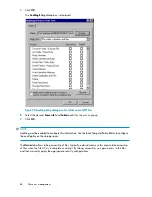
Backup and shadow copies
Shadow copies are only available on the network via the client application, and only at a file or
folder level as opposed to the entire volume. Hence, the standard backup associated with a volume
backup will not work to back up the previous versions of the file system. To answer this particular
issue, shadow copies are available for backup in two situations. If the backup software in question
supports the use of shadow copies and can communicate with underlying block device, it is supported,
and the previous version of the file system will be listed in the backup application as a complete file
system snapshot. If the built-in backup application NTbackup is used, the backup software forces a
snapshot, and then uses the snapshot as the means for backup. The user is unaware of this activity
and it is not self-evident although it does address the issue of open files.
Shadow Copy Transport
Shadow Copy Transport provides the ability to transport data on a Storage Area Network (SAN).
With a storage array and a VSS-aware hardware provider, it is possible to create a shadow copy
on one server and import it on another server. This process, essentially “virtual” transport, is
accomplished in a matter of minutes, regardless of the size of the data.
NOTE:
Shadow copy transport is supported only on Windows Server 2003 Enterprise Edition, Windows Storage
Server 2003 Enterprise Edition, and Windows Server 2003 Datacenter Edition. It is an advanced solution
that works only if it has a hardware provider on the storage array.
A shadow copy transport can be used for a number of purposes, including:
•
Tape backups
An alternative to traditional backup to tape processes is transport of shadow copies from the
production server onto a backup server, where they can then be backed up to tape. Like the other
two alternatives, this option removes backup traffic from the production server. While some backup
applications might be designed with the hardware provider software that enables transport, others
are not. The administrator should determine whether or not this functionality is included in the
backup application.
•
Data mining
The data in use by a particular production server is often useful to different groups or departments
within an organization. Rather than add additional traffic to the production server, a shadow copy
of the data can be made available through transport to another server. The shadow copy can
then be processed for different purposes, without any performance impact on the original server.
The transport process is accomplished through a series of DISKRAID command steps:
1.
Create a shadow copy of the source data on the source server (read-only).
2.
Mask off (hide) the shadow copy from the source server.
3.
Unmask the shadow copy to a target server.
4.
Optionally, clear the read-only flags on the shadow copy.
The data is now ready to use.
File server management
82
Содержание PROLIANT DL160 G5
Страница 1: ...HP ProLiant Storage Server user guide Part number 440584 005 First edition June 2008 ...
Страница 34: ...Installing and configuring the server 34 ...
Страница 52: ...Server components 52 ...
Страница 94: ...File server management 94 ...
Страница 112: ...Microsoft Services for Network File System MSNFS 112 ...
Страница 152: ...Troubleshooting servicing and maintenance 152 ...
Страница 154: ...System recovery 154 ...
Страница 160: ...BSMI notice Japanese notice Korean notice A B Class A equipment Class B equipment Regulatory compliance and safety 160 ...
Страница 174: ...Index 174 ...
















































